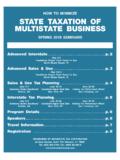Transcription of Topic 4 Designing Planar Magnetics - Texas Instruments
1 Topic 4 Designing Planar Magnetics 4-1 Designing Planar Magnetics Lloyd Dixon, Texas Instruments ABSTRACT Planar magnetic devices offer several advantages over their conventional counterparts. This paper dis-cusses the magnetic fields within the Planar structure and their effects on the distribution of high fre-quency currents in the windings. Strategies for optimizing Planar design are presented, and illustrated with design examples. Circuit topologies best suited for high frequency applications are discussed. I. ADVANTAGES OF Planar Magnetics In contrast to the helical windings of conven-tional magnetic devices, the windings of Planar transformers and inductors are located on flat sur-faces extending outward from the core centerleg. Fig. 1. Planar transformer. magnetic cores used with Planar devices have a different shape than conventional cores used with helical windings.
2 Compared to a conven-tional magnetic core of equal core volume, de-vices built with optimized Planar magnetic cores usually exhibit: Significantly reduced height (low profile) Greater surface area, resulting in improved heat dissipation capability. Greater magnetic cross-section area, enabling fewer turns Smaller winding area Winding structure facilitates interleaving Lower leakage inductance resulting from fewer turns and interleaved windings Less AC winding resistance Excellent reproducibility, enabled by winding structure In transformer applications, the winding con-figurations commonly employed in Planar de-vices are advantageous in reducing AC wind-ing losses. However, in inductors and flyback transformers using gapped centerlegs, the winding configuration often results in greater AC winding loss. II. magnetic FIELD PROPERTIES A magnetic field is actually stored energy.
3 The physical distribution of the magnetic field represents the distribution of this energy. Un-derstanding the properties of the magnetic field not only reveals the amount of stored energy and its locations, it also reveals how and where this energy is coupled to various electrical cir-cuit elements. magnetic / electric relationships are much simpler and easier to understand when using the SI system of units (rationalized MKS). When core and winding materials are specified in CGS or English units, it is nevertheless best to think in SI units throughout the design process, and then if necessary convert to other unit systems as the final step in the process. Tutorials on Magnetics design have been pre-sented at previous Unitrode/TI seminars. Most of this material has been consolidated into a Magnet-ics Design Handbook, MAG100A . This handbook, as well as all past seminar topics , is available for downloading from the web site Click on [Design Resources] [Power Management Training].
4 4-2 Inductance is simply an electrical circuit con-cept which enables the circuit designer to predict and quantify the effects of magnetically stored energy in the electrical circuit. Applying the basic principles of magnetic field behavior (discussed in earlier seminars) to Planar magnetic structures enables us to optimize the design and predict the magnitude of parasitic circuit elements such as leakage inductance. The magnetic field also is the dominant influence on the distribution of high frequency AC current in the windings, thereby determining AC winding losses. A. Review of magnetic Field Fundamentals Rules governing magnetic field behavior are summarized in Appendix I. Every magnetic field has two components: magnetic force, F, ( magnetic potential), and magnetic flux, Ф. magnetic force is directly pro-portional to current (Ampere s Law).
5 In fact, in the SI system of units, magnetic force, F, directly equals current units of magnetic force are ex-pressed in Amperes. Thus, 1 Ampere of current flowing in a conductor inevitably results in 1 Ampere of magnetic force. magnetic force can be described as a series of equipotential surfaces. The spacing of these sur-faces defines a force gradient a magnetic poten-tial gradient. The magnitude of this gradient at any location is called field intensity, H. Fig. 2. shows the leakage inductance in the left half of a Planar transformer structure. (In or-der to provide clarity of illustration, only three primary turns are used, and spacing between pri-mary and secondary is greatly exaggerated.) The light dash lines show the edge view of the mag-netic force equipotentials between primary and secondary windings.
6 The light solid lines repre-sent flux. The equipotential surfaces can be thought of as elastic membranes which terminate on current flow and are anchored on the oppos-ing currents which produce the field. Fig. 2. Cross-section of equipotentials and flux lines within a Planar transformer (one-half of transformer shown). DC and AC current distributions within the windings usually differ significantly. At high fre-quencies, the magnetic field arranges itself so as to minimize the rate of energy transfer between the electrical circuit and the field. The field pulls the opposing currents to the conductor surfaces closest to each other, as shown in Fig. 2., thereby minimizing the volume of the field (skin/proximity effect). Also, the currents spread across the opposing conductor surfaces so as to minimize energy density.
7 However, at low frequencies, the rate of en-ergy transfer between the circuit and the mag-netic field is very small. The rate of energy trans-fer into the conductor resistance is greater. There-fore, DC and low frequency currents distribute uniformly throughout the conductors so as to minimize I2R loss. III. THE TRUE TRANSFORMER Transformers in switching power supplies are used primarily in buck-derived topologies (for-ward converter, full bridge, half bridge, etc.) In a transformer, energy storage is usually undesir-able, but unavoidable appearing in the trans-former equivalent circuit as parasitic leakage in-ductance and magnetizing inductance. (Flyback transformers are misnamed they are actually coupled inductors. Energy storage is essential to their function.) In a true transformer (Fig. 2.), opposing currents flow simultaneously in primary and sec-ondary windings.
8 The Ampere-turns in the sec-ondary winding, resulting from load current, are canceled by equal and opposite Ampere-turns 4-3flowing in the primary. A small additional unop-posed magnetizing current also flows in the windings. This magnetizing current provides the small magnetic force necessary to push flux through the very low reluctance of the high per-meability magnetic core. The closed loops of this magnetizing flux link the primary and secondary windings to each other, thus providing the cou-pling which is essential for transformer operation (shown in Fig. 3.). Magnetizing flux and its asso-ciated magnetizing current change as a function of Volt-seconds per turn applied to the windings (Faraday's Law) independently of load current. Magnetizing inductance appears in the trans-former equivalent electrical circuit as a shunt element.
9 Much of the energy stored in the magnetizing inductance goes into hysteresis loss, the rest is usually dissipated in snubbers or clamps. If the core were ideal with infinite permeability the magnetizing inductance value would be infinite, and thus have no effect on circuit performance. Fig. 3. Magnetizing flux links the windings. Excluding magnetizing current, load-related Ampere-turns in primary and secondary windings cancel completely. Load current has no effect on the magnetizing flux in the core. magnetic force related to load current exists in only one place within the transformer in the region between primary and secondary windings where the cur-rents do not cancel. As shown in Fig. 2., the flux lines associated with this field between the wind-ings link half the energy of the field to primary and half to the secondary winding.
10 But these flux lines do not link the windings to each other. Thus, the coupling between windings is impaired. The energy stored in this inter-winding region appears in the equivalent electrical circuit as se-ries leakage inductances, (LLP, LLS). Each time the power switch turns off, energy stored in the leakage inductance usually ends up dissipated in snubbers or clamps, thus degrading power supply efficiency. Fig. 4. shows the electrical equivalent circuit of the transformer, including the magnetizing in-ductance and parasitic leakage inductance appor-tioned to primary and secondary windings. The ideal transformer is used to account for the ac-tual turns ratio and primary-secondary isolation. Leakage inductances are usually so small com-pared to the magnetizing inductance value that they can be combined, with negligible error, into a single leakage inductance value in an equiva-lent L network.

















